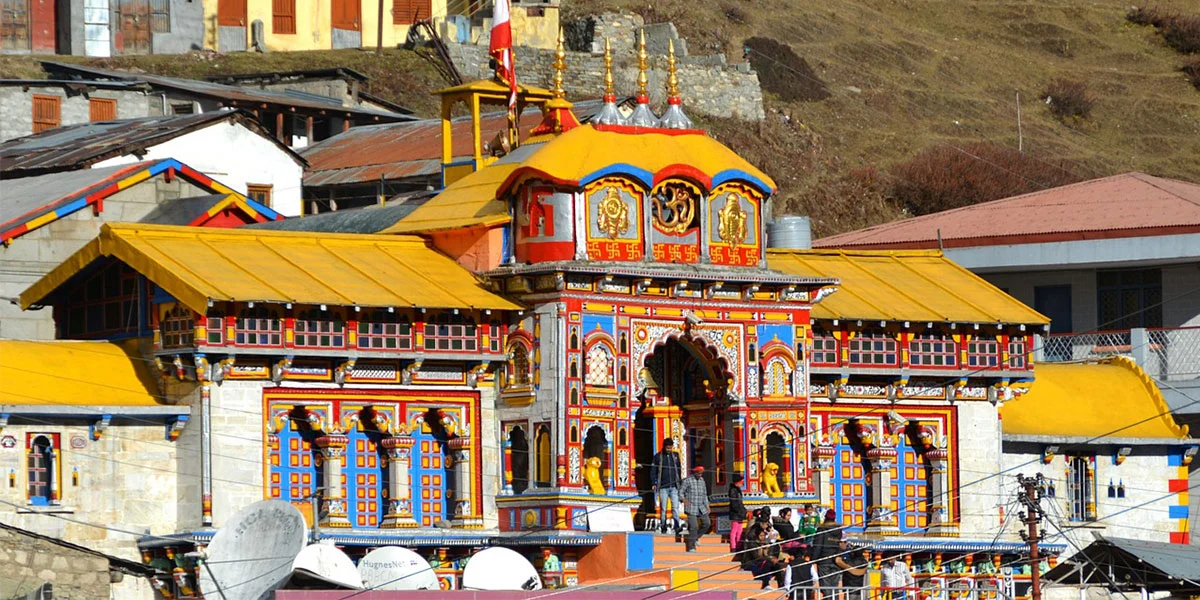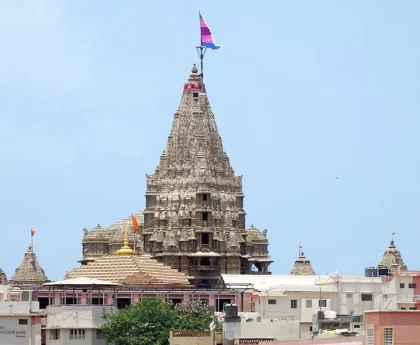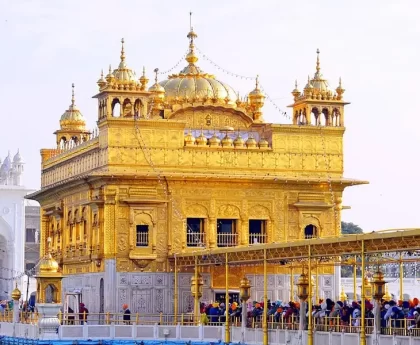Badrinath Temple, also known as Badrinarayan Temple, is one of the most revered Hindu pilgrimage sites in India. It is located in the town of Badrinath in the state of Uttarakhand. The temple is dedicated to Lord Vishnu and is part of the Char Dham pilgrimage circuit, which also includes Kedarnath, Gangotri, and Yamunotri.
Website: https://badrinath-kedarnath.gov.in/AboutUs/shri-badrinath.aspx
The history of Badrinath Temple dates back to ancient times and is steeped in mythology and legends. According to Hindu mythology, Badrinath is considered one of the holiest places because it is believed to be one of the “Char Dham” sites established by the great 8th-century philosopher and reformer Adi Shankaracharya.
The main deity of the temple is Lord Vishnu, who is worshiped in the form of Badrinarayan. The temple’s sanctum sanctorum houses a 3.3 feet tall black stone idol of Lord Vishnu sitting in a meditative pose.
The present-day temple structure was built in the 16th century by the Garhwal kings. Over the centuries, the temple has undergone several renovations and repairs, with the most recent one taking place in the 19th century by the King of Jaipur, Maharaja Sawai Man Singh II.
The temple is situated along the banks of the Alaknanda River, surrounded by the picturesque Himalayan mountains. It remains open to pilgrims and visitors from late April to early November, and during the winter months, the deity is brought down to Joshimath, where worship continues.
Badrinath Temple holds great significance in Hindu religious beliefs and attracts thousands of devotees from all over the country and around the world. The temple’s location, amidst the stunning natural beauty of the Himalayas, adds to its spiritual appeal and makes it a cherished destination for pilgrims and tourists alike.
How to Reach Badrinath Temple?
Reaching Badrinath Temple requires traveling to the town of Badrinath in the state of Uttarakhand, India. The temple is situated in the Garhwal region of the Himalayas.
Here are the different modes of transportation to reach Badrinath:
- By Air: The nearest airport to Badrinath is the Jolly Grant Airport in Dehradun, which is approximately 315 kilometers away. From the airport, you can hire a taxi or take a bus to reach Badrinath. The drive from Dehradun to Badrinath takes around 10-12 hours.
- By Train: The nearest major railway station to Badrinath is Rishikesh, which is about 295 kilometers away. From Rishikesh, you can hire a taxi or take a bus to reach Badrinath. The journey by road takes around 9-10 hours.
- By Road: Badrinath is well-connected by roads, and you can reach the town by bus, taxi, or private vehicle. The journey by road can take longer, depending on the starting point. Major cities like Delhi, Haridwar, Rishikesh, and Dehradun have regular bus services to Badrinath during the pilgrimage season.
- Pilgrimage Tours: Many travel agencies and tour operators offer organized pilgrimage tours to Badrinath, which include transportation, accommodation, and other facilities. This can be a convenient option for those who prefer a guided tour.
- Helicopter Services: During the pilgrimage season, helicopter services are also available from Dehradun and other nearby locations to Badrinath. This option provides a faster and more comfortable way to reach the temple.
Road Route 1: KEDARNATH TO BADARINATH (247 km)
Kedarnath – (14 km trek) Gaurikund – (5 km) Sonprayag – (4 km) Rampur – (9 km) Phata – (14 km) Guptkashi – (7 km) Kund – (19 km) Agastyamuni – (8 km) Tilwara – (8 km) Rudraprayag – (20 km) Gauchar – (12 km) Karnaprayag (20 km) Nandprayag – (11 km) Chamoli – (8 km) Birahi – (9km) Pipalkoti – (5 km) Garur Ganga – (15 km) Helang (14 km) Joshimath – (13 km) Vishnuprayag – (8 km) Govindghat – (3 km) Pandukeshwar – (10 km) Hanumanchatti – (11 km) Shri Badarinath.
Road Route 2: KEDARNATH TO BADARINATH (229 km)
Via Guptakashi – Ukhimath – Chopta – Gopeshwar – Chamoli – Pipalkoti
Kedarnath to Kund (53 km) – (6km) Ukhimath – (22 km) Dogalbhitta – (7 km) Chopta – (27 km) Mandal – (8 km) Gopeshwar – (10 km) Chamoli – from Chamoli to Badarinathji (96 km) route is same as given as above.
Road Route 3: HARIDWAR/RISHIKESH TO BADARINATH (324 km), RISHIKESH TO BADARINATH (298 km)
Haridwar – (24 km) Rishikeh – (71 km) Deoprayag – (30 km) Kirtinagar – (4 kkm) Shrinagar – (34 km) Rudraprayag – (20 km) Gauchar – (12 km) Karnaprayag – (20 km) Nandprayag – (11 km) Chamoli – (8 km) Birahi – (9 km) Pipalkoti – (5 km) Garur Ganga – (15 km) Helang – (14 km) Joshinath – (13 km) Vishnuprayag – (8 km) Govindghat – (3 km) Pandukeshwar – (10 km) Hanumanchatti – (11 km) Shri Badarinathji.
It’s important to note that the route to Badrinath passes through hilly terrain, and the roads can be challenging, especially during the monsoon and winter seasons. It is advisable to check the weather and road conditions before planning your trip and to ensure your safety during the journey.
Before embarking on the pilgrimage to Badrinath Temple, it’s recommended to have proper travel arrangements, carry essential supplies, and be prepared for any weather changes that may occur during the trip.
Website: https://badrinath-kedarnath.gov.in/AboutUs/shri-badrinath.aspx
Best time to visit Badarinath temple
The best time to visit Badrinath Temple is during the pilgrimage season, which typically starts from late April or early May and lasts until early November. The temple remains closed during the winter months due to heavy snowfall and harsh weather conditions. The specific opening and closing dates of the temple may vary each year and are determined by Hindu religious authorities.
The ideal time to visit Badrinath Temple is from May to June and from September to October. During these months, the weather is pleasant, and the temperature is moderate, making it comfortable for pilgrimage and sightseeing. The natural beauty of the Himalayas is at its peak during this time, offering breathtaking views of the surrounding mountains and landscapes.
The months of May and June are considered the peak pilgrimage season, attracting a large number of devotees and tourists. This period also coincides with various religious festivals and celebrations, adding to the spiritual atmosphere.
September and October are also favorable months to visit Badrinath, as the weather remains pleasant, and the number of tourists decreases compared to the peak season. This allows for a more peaceful and serene experience at the temple.
It is advisable to avoid visiting Badrinath during the monsoon season, which lasts from July to early September. Heavy rains can cause landslides and disrupt travel plans, making the journey challenging and unsafe.
Additionally, the temple remains closed during the winter season (November to April) due to extreme cold and heavy snowfall in the region. The idol of Lord Vishnu is brought down to Joshimath during this time, where worship continues at the Narsimha Temple.
Before planning your visit to Badrinath, it is recommended to check the opening dates and weather conditions to ensure a safe and comfortable pilgrimage experience.
Puja time of Badrinath Temple
The puja timings at Badrinath Temple may vary depending on the season and specific dates. However,
a general schedule of the daily pujas at the temple is as follows:
- Morning Pujas:
- Mangala Aarti: The first puja of the day, performed early in the morning before sunrise.
- Geet Govind: A ritual of singing devotional songs dedicated to Lord Vishnu.
- Afternoon Pujas:
- Bhog Aarti: A puja where offerings of food (bhog) are made to the deity.
- Evening Pujas:
- Sandhya Aarti: The evening aarti performed at sunset.
Website: https://badrinath-kedarnath.gov.in/AboutUs/shri-badrinath.aspx
Hotels near by Badrinath Temple
If you don’t like this article/post please share your feedback.






